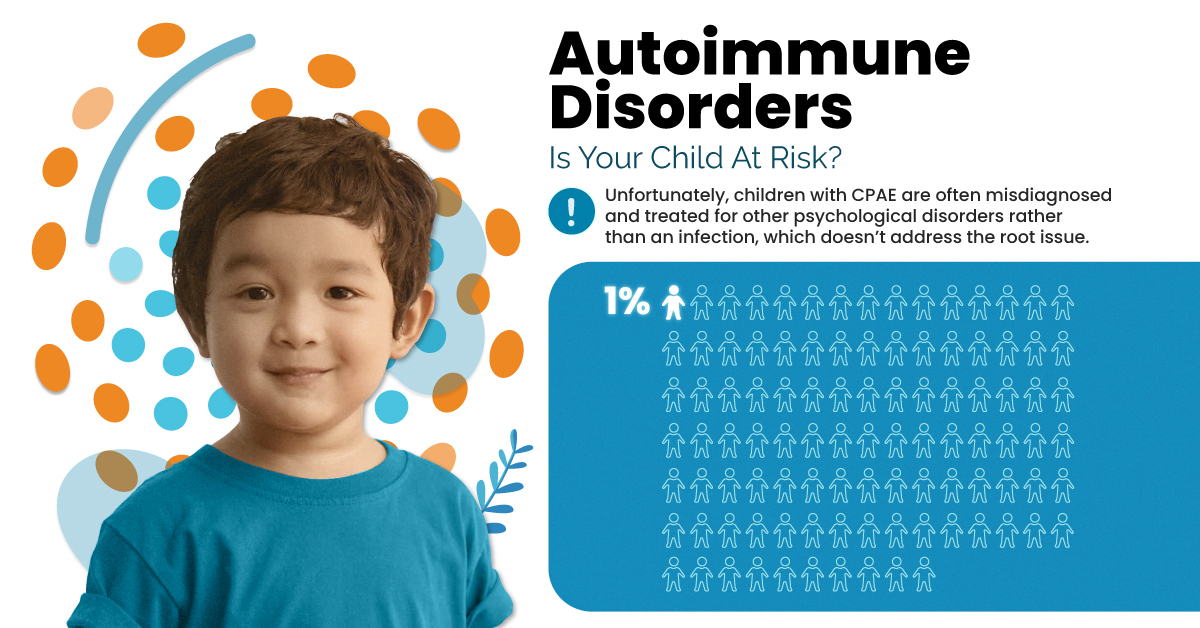Autoimmune Disorders: Is Your Child At Risk of PANS or PANDAS?
The following content is sponsored by The Pace Foundation.

Autoimmune Disorders: Is Your Child At Risk of PANS or PANDAS?
Every year, millions of young children and adolescents get sick with the flu, or some sort of viral or bacterial infection.
For a small number of children, these infections trigger an autoimmune response that causes acute behavior changes. This response is called Children’s Postinfectious Autoimmune Encephalopathy (CPAE), and its symptoms appear similar to OCD or severe anxiety.
How can you tell if your child is suffering from a CPAE? This graphic, presented by the PACE Foundation, outlines the two types of CPAEs—PANS and PANDAS—and explains what symptoms to look for, and where to seek help if needed.
What is CPAE?
CPAE is a type of autoimmune disorder that causes your immune system to accidentally attack healthy cells. In the case of CPAE, this reaction is triggered by an infection.
The area of the body that’s affected by CPAE is the brain. Specifically, it attacks the basal ganglia, which is the same region of the brain that’s been linked to OCD and Tourette’s syndrome.
To date, there are two types of CPAEs:
- PANS (Pediatric acute-onset neuropsychiatric syndrome): A sudden onset of OCD-like symptoms, thought to be triggered by infections or inflammatory reactions.
- PANDAS (Pediatric autoimmune neuropsychiatric disorder associated with streptococcus): A subset of PANs, characterized by an acute onset of OCD or tics. It’s caused by a streptococcal infection like strep throat.
Some key symptoms to look out for include:
- Regressive bedwetting
- Emotionally erratic behavior
- Depression or severely oppositional behavior
- Separation anxiety
- Trouble eating
- Tics
It’s important to note that, when a child has PANS or PANDAS, their symptoms develop rapidly, or seem to come out of nowhere.
How to Treat PANS or PANDAS
If you think your child may have PANDAS or PANS, contact your child’s doctor right away.
While PANS or PANDAS could come back if your child gets a viral or bacterial infection again, there are a number of treatments that can help children manage their condition, so they can live healthy, nearly-symptom-free lives.
Antibiotics may be enough for some patients, while others might need a mixture of antibiotics, steroids, and/or psychiatric treatments.
There are several CPAE/PANS clinics throughout the U.S., founded by the PACE Foundation, which has helped facilitate a national standard of care for CPAE treatment throughout America.
Pace Treatment Centers Across the U.S.
The Pace Foundation has established partnerships with major universities and institutions, such as the National Institutes of Health (NIH) and the University of Arizona Center of Excellence, to treat children with CPAE.
| Treatment Center | State | Clinic Type |
|---|---|---|
| Stanford University | California | Partner clinic |
| University of California | California | Sponsored clinic |
| University of Arizona Center of Excellence | Arizona | Sponsored clinic |
| Banner Children's at Desert (Affiliated with University of Arizona) | Arizona | Sponsored clinic |
| University of Arkansas Center of Excellence | Arkansas | Sponsored clinic |
| Harvard University | Massachusetts | Partner clinic |
| Dartmouth University | New Hampshire | Sponsored clinic |
| University of Wisconsin | Wisconsin | Sponsored clinic |
| Greater Regional Health Center | Iowa | Partner clinic |
While there’s still more to learn about these autoimmune disorders, there is hope for children diagnosed with PANS or PANDAS. For additional resources on diagnosis and treatment of CPAEs, visit the Pace Foundation’s website.
PACE Foundation is a non-profit dedicated to helping kids with CPAE and supporting their families through education, advocacy, and research.
-

 Sponsored3 years ago
Sponsored3 years agoMore Than Precious: Silver’s Role in the New Energy Era (Part 3 of 3)
Long known as a precious metal, silver in solar and EV technologies will redefine its role and importance to a greener economy.
-

 Sponsored7 years ago
Sponsored7 years agoThe History and Evolution of the Video Games Market
Everything from Pong to the rise of mobile gaming and AR/VR. Learn about the $100 billion video games market in this giant infographic.
-

 Sponsored8 years ago
Sponsored8 years agoThe Extraordinary Raw Materials in an iPhone 6s
Over 700 million iPhones have now been sold, but the iPhone would not exist if it were not for the raw materials that make the technology...
-

 Sponsored8 years ago
Sponsored8 years agoThe Industrial Internet, and How It’s Revolutionizing Mining
The convergence of the global industrial sector with big data and the internet of things, or the Industrial Internet, will revolutionize how mining works.


